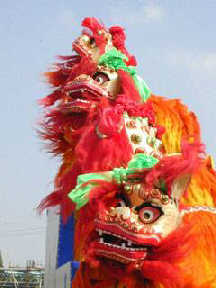 Lion dance is an outstanding traditional folk art in China. When it is the Lantern Festival or other festive occasion, people often organize lion dance to add to the fun. If well performed, the lion dance is believed to bring luck and happiness.
Lion dance is an outstanding traditional folk art in China. When it is the Lantern Festival or other festive occasion, people often organize lion dance to add to the fun. If well performed, the lion dance is believed to bring luck and happiness.
The lion dance has a long history in China. These were recorded over thousands of years ago. In the Tang Dynasty (618-907), the lion dance was performed in a group of five lions of different colors. Each lion was followed by twelve men dressed in colorful costumes, with a red band round the forehead and a red colored brush in hand. These people were called "lion-men" and they danced in tempo to the musical pieces calledTaipinmelody. During the more than 1,000 years of development, lion dance has developed into two major genres -- Northern Lion Dance and Southern Lion Dance.
 Northern Lion Dance
Northern Lion Dance
The Northern Lion Dance has a longer history than any other forms of lion dance. It is said that in the Northern Wei Dynasty (386-534), Emperor Wudi launched an expedition to Hexi in Gansu Province, and took captive of more than 100,000 Mongols. The emperor ordered the Mongols to perform dance and other entertainment. More than 30 Mongolian warriors held wood carved animal heads, two big and five small, and wore animal skins, dancing before the emperor. The emperor was very pleased and named it Northern Wei Auspicious Lion, and allowed the captives to return home. Then lion dance was popular in northern China, and the Northern Lion Dance came into being.
The Northern Lion Dance mainly focuses on the performance of martial lion dance, i.e. the Auspicious Lion of the Northern Wei Dynasty. Dance of small lion is performed by one person, and dance of big lion is played by two persons, with one person wielding the lion head while standing, and the other wielding the lion body and tail while stooping down. Guided by the lion dancers, the lion writhes, falls forward, jumps and makes a bow, as well as some other highly difficult movements such as walking on wooden or bamboo stakes, jumping over a table, and stepping on a rolling ball, etc.
 Southern Lion Dance
Southern Lion Dance
There are several legends about the Southern Lion Dance in China. One of the legends has it that in the Qing Dynasty (1644-1911), Emperor Qianlong dreamed about the pilgrim of an auspicious animal in colorful hair on his inspection tour south of the lower reaches of the Yangtze River. After his return to Beijing, the capital, the emperor ordered his men to make one according to the image of the auspicious animal he dreamed about. He ordered some people to wield whenever there was a festival or a ceremony, indicating to make the state prosperous and people peaceful.
The Southern Lion Dance mainly focuses on the performance of civilized lion dance. The performance attaches much attention to the movements like scratching an itch, shaking the hair, licking the hair and so on.
Ancient people regarded lion as the symbol of braveness and strength, and thought it could drive away the evil and protect the human and livestock. Therefore, performing lion dance in the Lantern Festival and other big celebrations became a custom where people can pray for good luck and safety.
